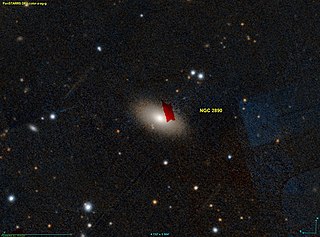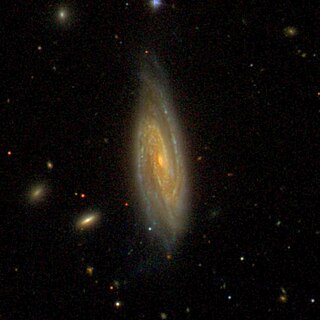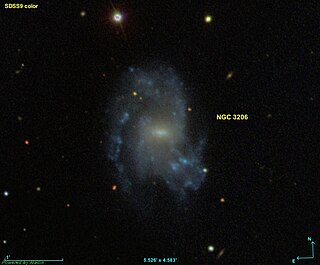
NGC 7253 is a pair of spiral galaxies in the constellation Pegasus. It was discovered by the German-British astronomer Albert Marth on 9 September 1863. It is listed in Halton Arp's Atlas of Peculiar Galaxies as Arp 278, as an example of gravitationally interacting galaxies.

NGC 7171 is a barred spiral galaxy in the constellation of Aquarius. Its velocity with respect to the cosmic microwave background is 2388 ± 24 km/s, which corresponds to a Hubble distance of 35.22 ± 2.49 Mpc. It was discovered by German–British astronomer William Herschel on 12 August 1787.

NGC 3535 is a spiral galaxy in the constellation of Leo. Its velocity with respect to the cosmic microwave background is 7289 ± 25 km/s, which corresponds to a Hubble distance of 107.51 ± 7.54 Mpc. It was discovered by German-British astronomer William Herschel on 18 April 1784.

NGC 2528 is an intermediate spiral galaxy in the constellation of Lynx. Its velocity with respect to the cosmic microwave background is 4098 ± 12 km/s, which corresponds to a Hubble distance of 60.45 ± 4.23 Mpc. It was discovered by French astronomer Édouard Stephan on 22 January 1877.

NGC 5988 is a large spiral galaxy in the constellation of Serpens. Its velocity with respect to the cosmic microwave background is 10697 ± 10 km/s, which corresponds to a Hubble distance of 157.78 ± 11.05 Mpc. It was discovered by American astronomer Lewis Swift on 17 April 1887.

NGC 2890 is a lenticular galaxy in the constellation of Hydra. Its velocity with respect to the cosmic microwave background is 5455 ± 37 km/s, which corresponds to a Hubble distance of 80.45 ± 5.67 Mpc. It was discovered by American astronomer Francis Leavenworth on 11 January 1886.

NGC 5875 is an spiral galaxy in the constellation of Boötes. Its velocity with respect to the cosmic microwave background is 3585 ± 6 km/s, which corresponds to a Hubble distance of 52.87 ± 3.70 Mpc. It was discovered by German-British astronomer William Herschel on 1 May 1788.

NGC 4734 is a spiral galaxy in the constellation of Virgo. Its velocity with respect to the cosmic microwave background is 7835 ± 23 km/s, which corresponds to a Hubble distance of 115.56 ± 8.10 Mpc. It was discovered by British astronomer John Herschel on 7 April 1828.

NGC 2283 is a barred spiral galaxy in the constellation of Canis Major. Its velocity with respect to the cosmic microwave background is 994 ± 11 km/s, which corresponds to a Hubble distance of 14.66 ± 1.04 Mpc. It was discovered by German-British astronomer William Herschel on 6 February 1785.

NGC 5260 is a barred spiral galaxy in the constellation of Hydra. Its velocity with respect to the cosmic microwave background is 6789 ± 21 km/s, which corresponds to a Hubble distance of 100.13 ± 7.02 Mpc. It was discovered by American astronomer Lewis Swift on 6 April 1885.

NGC 2642 is a barred spiral galaxy in the constellation of Hydra. Its velocity with respect to the cosmic microwave background is 4632 ± 21 km/s, which corresponds to a Hubble distance of 68.32 ± 4.79 Mpc. It was discovered by British astronomer John Herschel on 19 February 1830.

NGC 2804 is a lenticular galaxy in the constellation of Cancer. Its velocity with respect to the cosmic microwave background is 8580 ± 20 km/s, which corresponds to a Hubble distance of 126.55 ± 8.86 Mpc. It was discovered by British astronomer John Herschel on 24 February 1827. This galaxy was also observed by the French astronomer Stéphane Javelle on 9 April 1896, and was later added to the Index Catalogue as IC 2455.

NGC 958 is a barred spiral galaxy in the constellation of Cetus. Its velocity with respect to the cosmic microwave background is 5505 ± 17 km/s, which corresponds to a Hubble distance of 81.20 ± 5.69 Mpc. However, 19 non-redshift measurements give a distance of 58.93 ± 12.91 Mpc. The galaxy was discovered by German-British astronomer William Herschel on 20 September 1784.

NGC 3557 is a elliptical galaxy in the constellation of Centaurus. Its velocity with respect to the cosmic microwave background is 3398 ± 23 km/s, which corresponds to a Hubble distance of 50.12 ± 3.53 Mpc. However, 20 non-redshift measurements give a distance of 32.905 ± 2.289. The galaxy was discovered by British astronomer John Herschel on 21 April 1835.

NGC 2927 is a barred spiral galaxy in the constellation of Leo. Its velocity with respect to the cosmic microwave background is 7830 ± 20 km/s, which corresponds to a Hubble distance of 115.49 ± 8.09 Mpc. In addition, three non-redshift measurements give a distance of 120.667 ± 0.882. The galaxy was discovered by German astronomer Heinrich d'Arrest on 21 February 1863.

NGC 4375 is a barred spiral galaxy in the constellation of Coma Berenices. Its velocity with respect to the cosmic microwave background is 9325 ± 20 km/s, which corresponds to a Hubble distance of 137.54 ± 9.63 Mpc. However, four non-redshift measurements give a distance of 105.5 Mpc. The galaxy was discovered by German-British astronomer William Herschel on 11 April 1785.

NGC 3052 is a intermediate spiral galaxy in the constellation of Hydra. Its velocity with respect to the cosmic microwave background is 4122 ± 24 km/s, which corresponds to a Hubble distance of 60.79 ± 4.27 Mpc. However, 19 non redshift measurements give a distance of 42.563 ± 6.434 Mpc. The galaxy was discovered by German-British astronomer William Herschel on 7 February 1785.

NGC 5876 is a barred spiral galaxy in the constellation of Boötes. Its velocity with respect to the cosmic microwave background is 3325 ± 5 km/s, which corresponds to a Hubble distance of 49.05 ± 3.43 Mpc. However, three non redshift measurements give a distance of 65.6 ± 0.346 Mpc. The galaxy was discovered by American astronomer Lewis Swift on 11 June 1885. Swift observed the galaxy again on August 27, 1888, and not realizing that he had already observed it, entered the galaxy into the Index Catalogue as IC 1111.

NGC 3206 is a barred spiral galaxy in the constellation of Ursa Major. Its velocity with respect to the cosmic microwave background is 1309 ± 11 km/s, which corresponds to a Hubble distance of 19.31 ± 1.36 Mpc. In addition, 11 non redshift measurements give a distance of 17.582 ± 1.088 Mpc. The galaxy was discovered by German-British astronomer William Herschel on 8 April 1793.

NGC 3362 is a intermediate spiral galaxy in the constellation of Leo. Its velocity with respect to the cosmic microwave background is 8676 ± 25 km/s, which corresponds to a Hubble distance of 127.97 ± 8.97 Mpc. However, three non redshift measurements give a distance of 95.8 ± 3.984 Mpc. The galaxy was discovered by German astronomer Albert Marth on 22 March 1865.




















